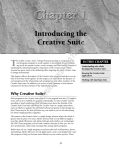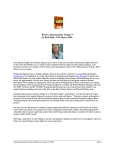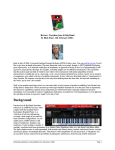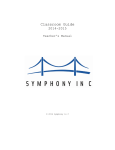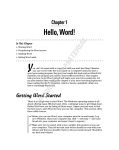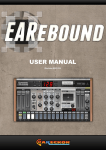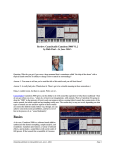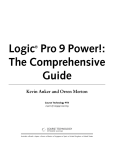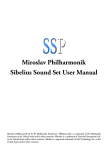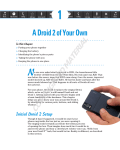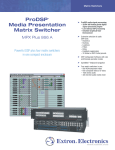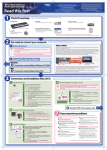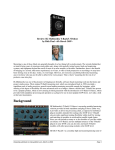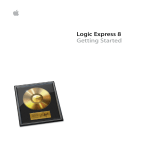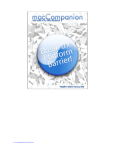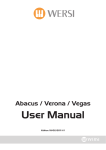Download Garritan Personal Orchestra
Transcript
Review: Garritan Personal Orchestra by Rick Paul - 7th July 2004 - Would you mind very much if I skip ahead to the verdict right here? I know it's customary to save conclusions for the end so as not to ruin any surprises. I suppose there is the risk some of you won't read any further because you don't much care about details and were just planning to skip to the end anyway, and now that I'm giving you a shortcut you might not even accidentally notice any of the details. I'll take my chances, though. Here goes: Garritan Personal Orchestra raises the bar for affordable, realistic, playable, and just plain fun orchestral simulations. There, I've done it. Those of you who were just waiting for that part are no longer reading this. (Hmm, if I say that last sentence in a forest and, ... Oh, never mind!) For the rest of you, though, there's a method to my madness. In particular, it took me all of a few minutes of playing around with GPO to come to that basic conclusion, so I thought it would be appropriate to share that right up front in this review. That initial reaction, however, while reflecting the spirit of what is coming in the remainder of this review, barely scratches the surface of GPO. It's like one of those movies where you get told the ending at the start of the movie, then most everything else is a flashback, perhaps up to the very ending, where you might get a few added twists. What's interesting isn't so much the ending, or in this case the conclusion, itself. Rather, it is all the details, including surprise twists and turns along the way, that lead to that conclusion. So grab your popcorn (just don't get butter on the keyboard) and get comfortable. We're off! Background Garritan Personal Orchestra (GPO) is among the relatively new breed of products that blur the line between a software-based sample player and a sample library. In fact, GPO includes Native Instruments' KONTAKT Player to handle the playback duties for its roughly 1.8GB orchestral sample Originally published on CakewalkNet.com, July 7, 2004. Page 1 library, but KONTAKT users can also load the samples directly, if desired. Garritan's providing the KONTAKT Player is thus a convenience which ensures that even users who don't have KONTAKT can play the samples back in their optimal form, without needing any sample format conversions which could potentially lose information. However, as we'll see later in this review, there are some benefits to Garritan's providing the KONTAKT Player, even for existing KONTAKT users. GPO's sample library, programmed by Tom Hopkins, includes all the basic instrumental groups you'd expect to find in an orchestral collection. For example, all common types of strings (including harps), brass, woodwinds, and orchestral percussion are included, where applicable in both solo and ensemble forms (more on that distinction below). There are also some less expected, but certainly nice to have, instruments, primarily from the keyboard category, such as a pipe organ, harpsichord, celeste, and even a Steinway grand piano. We'll explore the sample collection in more depth below, but the short summary is that GPO covers all the expected bases and then some, and does so in high quality fashion. What I've described thus far may have some of you yawning, "yeah, so another orchestral sample collection with built-in player -- so what?" Where GPO distinguishes itself isn't so much in the breadth of its sample collection (which is certainly more than solid). Rather, it is in the depth of programming of each individual instrument, the consistency in that programming across related instrument types, and how these relate to the playability, realism, and expressiveness of the instruments. We'll get to more specifics below, but the general idea is to give the musician using a keyboard-based MIDI controller the ability to manipulate the sampled instrument in ways that cover as much of what the instrument can do as possible. Further, the instruments must do this while still making the keyboardbased playing techniques relatively natural and, significantly, without having to switch sample sets to get to those capabilities. GPO's four CD distribution package comes in DVD-style packaging. The first three CDs include the sample library, a variety of plug-in formats (DXi2, VST2, and RTAS for Windows and AudioUnits and RTAS for Macintosh OSX), and a standalone version of GPO that uses ASIO, MME, or DirectSound drivers on Windows or CoreAudio drivers on the Mac. The fourth CD provides a number of "goodies". Among these are a multi-instance GPO player, GPO Studio, which allows GPO to appear as MIDI ports to arbitrary MIDI programs such as notation programs; the Ambience reverb plug-in; the GenieSoft Overture SE notation program; Cubase VST 4.0 OEM; and a few other utility programs. The general gist of the extras is to allow users to have everything they need to create and realize orchestrations, no matter what software they may have had prior to acquiring GPO. A 60-page paper user manual is provided. About two thirds of that covers GPO itself, while the remainder covers the extra included programs and how to integrate them with GPO. On-line PDF and/or on-line help format manuals are also provided to go into more detail on the extra programs. Installation of GPO itself, which includes the KONTAKT Player, was straightforward and uneventful. Activation via Native Instruments' on-line registration and activation facility, or equivalent manual processes, is required. I used the automated facility, and it went quickly and without a hitch. It is also recommended to update to the latest version of the KONTAKT Player, which is V1.0.2.008 as of this writing. That is the version used for this review. The extra programs each have their own installation routines, which are located on the fourth CD of the distribution set. Installing those programs was also largely uneventful, though I was disappointed that the Cubase VST 4.0 installation commandeered the ".MID" (MIDI file type) association on my system without giving me the option to have it not do that. (Given CakewalkNet is primarily aimed at SONAR users, readers may wish to forego the installation of Cubase VST altogether.) It also turns out GPO Studio has default installation path dependencies built into its templates as a result of limitations of the current version of the KONTAKT Player (more on this below). GPO currently carries an "introductory price" of $249, and all the retail prices I've seen for it are very close to that point. Note, though, that the Garritan web site suggests a price increase will be coming. It does not suggest what the new price will be, or when it is coming. Originally published on CakewalkNet.com, July 7, 2004. Page 2 Except as specifically noted otherwise below, the hands-on product testing conducted for this review was carried out in SONAR 3.1.1 Producer Edition. The DXi2 version of GPO was used within SONAR. The Cast I won't bore you with the entire instrument list -- if you want that you can check it out on the Garritan site. Let's get a flavor, though: Starting with the strings, you will find not only section and solo sounds for each instrument, but also individual instrument sounds geared toward building ensembles. The ensemble-building stringed instruments do not share samples with one another, and so do not exhibit the phasing and other artifacts you might get if trying to build ensembles with multiple copies of the same sampled instrument. They are also each panned slightly differently, and with volume settings to position them slightly differently in the mix, to emulate the positioning of players in a real orchestra. This makes for quick and easy ensemble building. To give an idea of the kind of variety that exists within the GPO samples, there are 3 solo violins and 9 violins intended for building ensembles. Each of the ensemble instruments is based on a different actual violin. Not just any violins, either. We are talking high-end, often vintage instruments, such as 18th century violins by the likes of Stradivarius, Guarneri, and Gagliano. Garritan indicates that the original stringed instruments alone are collectively valued at upwards of ten million dollars. While there aren't as many violas, cellos, and double basses as there are violins -- just as is the case in a real orchestra -- there are multiple instruments of each type aimed at building ensembles. There are also solo instruments of each type -- three of those in the case of cellos. What you won't find in most of the individual string instruments is lots of different instruments for different articulations. The one exception on that count is pizzicato articulations for the solo instruments. By and large, though, the multiple articulations needed for playing realistic string parts are achieved through playing techniques (more on that below). This may mean a bit more of a front-end learning curve for getting comfortable with playing the samples, but should pay off nicely in improved efficiency later on. When you compare just playing the parts on a single sampled instrument per individual instrument part to having to switch sample sets frequently depending on which articulations are used, the productivity improvements of the former approach should be obvious. Besides the solo and ensemble-building stringed instruments there are also string sections. If you're in a hurry, and don't have time to track multiple individual instruments, the section strings will get you on your way more quickly. For best realism, though, building up your ensembles from individual instruments is the way to go. Or augment several ensemble-building instruments with section strings to get larger groups more quickly. Unlike the individual stringed instruments, the section strings do provide sample sets geared toward various articulations, such as short bows, tremolo, pizzicato, sordino (with mutes), and trills. Moving on to woodwinds reveals the full range of instruments from piccolo down to contrabassoon, including somewhat rarer instrument types such as alto and bass flutes and E flat, bass, and contrabass clarinets. Of course, the more standard fare (i.e. flutes, B flat clarinets, oboe, English horn, and bassoon) is there. The more common instruments have both solo and ensemble-building variations, while the rarer ones may only have one or two solo instruments. Most articulations are covered by playing techniques, but flutes and piccolos do get some extra samples to cover flutter tonguing and vibrato. The brass section includes the usual range of suspects (trumpets, tenor trombones, French horns, and tubas) plus piccolo trumpet, bass trombones, and contra tuba. Select solo and ensemble-building instruments come in muted varieties in addition to the standard unmuted versions. Garritan also provides overlay samples intended to be layered along with other instruments for creating a fuller section sound. Here again, most articulations are handled via playing techniques. The percussion category finds a wide variety of pitched and unpitched orchestral percussion instruments, and even a wind machine. Pitched percussion includes timpani, glockenspiel, marimba, xylophone, vibraphone, crotales, Originally published on CakewalkNet.com, July 7, 2004. Page 3 tubular bells and glass harmonica. Unpitched percussion include various drums, cymbals (including gongs), and percussive toys (e.g. shakers, tambourine, claves, etc.). In addition to individual instrument samples, there are assorted grouped samples, such as for various types of cymbals, a grouping of the most common orchestral percussion instruments, and one of "percussion toys". Last, but certainly not least, is the keyboards and harps category. This category includes a 9' Steinway concert grand piano, along with a celeste, pipe organ, harpsichord, celeste, and two harps. We're not just talking gratuitously included instruments here, either. For example, the main piano sample comes in at 244 MB when loaded into the KONTAKT Player (a "lite" version at 165 MB is also available in case memory is tight). There are also two "duo" pianos available that do not share samples in common to allow for using them together for duet purposes. The harpsichord includes three key-switched stops settings, and the pipe organ includes a number of different stops settings as well as pedals coverage. Each of the harps have sample sets for harmonics, white key only sample sets geared toward glissandos, along with a standard chromatic sample set. We'll get into special controls and playing techniques below. To wind up our overview of the sample library's contents, though, my best summary would be that GPO provides the breadth of instrumentation needed to simulate anything from solo violin to a string or brass quartet to a full orchestra, including most common special configurations. It does this by providing high quality instruments and sufficient variations of each instrument to build ensembles that go beyond what can be done playing section sounds or by cloning a limited number of individual instruments. The Director (You) Okay, so GPO has a full orchestra's worth of high quality samples. Couldn't that be said about other orchestral sample sets as well? Perhaps so, especially if you disregard price point, but just having a set of well-recorded samples does not a believable orchestral simulation make. Real instrumentalists coax a lot more than notes out of their instruments. Sure the notes are part of what good players produce, but notes alone, while music, aren't necessarily musical. A musical performance -- i.e. one that invokes an emotional response in the listener -- also includes dynamic changes, tonal variations, articulation differences to suit phrasing, and even subtle human imperfections such as variations in pitch and tone that, technically, arise from mistakes or a player's limitations. How does a set of sampled acoustic instrument sounds provide for these sorts of nuances? To get more concrete here, let's look simply at the violin. If you've played synthesized or sampled violin sounds from a keyboard before, you have no doubt had the experience that what you are playing sounds "sort of" like a violin, but wouldn't fool your tin-eared, tone deaf Uncle Ernie, no less a more discriminating listener. Why is that? The sound you hear emanating from a violin is the product of many elements coming together. For example, there is the acoustical design of the violin itself, the material the bow is made of, the pressure of the bow on the strings, the speed with which the player moves the bow across the strings, the acoustical properties of the strings themselves, finger positions of the player, the pressure of the player's fingers on the strings, whether the note is played at the start of a bow stroke or later on (and how much later on), the direction of the bow, etc. Vary any element (e.g. the angle of the bow), and what comes out may change slightly or even significantly. Keep in mind more than one element can be varied at a time. For example, when switching notes the player will be moving his or her fingers at the same time the bow is moving across the strings, and the actual angle of the fingers and the bow with respect to their respective parts of the strings will change slightly. Also, unlike most keyboard instruments, where the key struck dictates the pitch that will come out of the instrument, and that pitch selection is perfectly repeatable, violin players select pitches through continuously variable finger positions on the strings. To gain accuracy in pitch selection, they use a combination of their ears and memorized hand and finger positions. Neither is perfect, and there will be slight variations in pitch between instances of the same note. This is especially true in fast passages where fingers and pitch decisions must be made rapidly, and there isn't time to let the ear make corrections to an evolving pitch as there might be in a slower passage. Originally published on CakewalkNet.com, July 7, 2004. Page 4 To put it another way, the sounds we hear come from the interaction of instrument design, the player's interpretation of the notes on the page, the player's skill and technique, and good old human error. The sounds we hear will vary over time, with some of that variation based on deliberate decisions made by the player and some based on relatively random factors such as human error and the player's physical and technical limitations. Truly skilled acoustic musicians marshal all these factors to yield a more emotional performance, but what is the poor keyboard player to do when trying to simulate a complex acoustic instrument based on synthesized or sampled sounds? Most sampled violin sounds use keyboard velocity for volume and possibly timbre. Some might add support for legato via sustain pedal, perhaps vibrato from a mod wheel, and maybe a bit more obscure things here and there. To get different articulations, though, such as you might achieve from bow pressure, you will by and large need to change sample sets. This can make it truly hard to just "play the instrument" in a musical way to achieve effects similar to what a real violin player might achieve. While GPO won't turn you into a virtuoso violinist likely to fool orchestral audiophiles, GPO's violin sample programming, combined with the control possibilities available through the KONTAKT Player, do provide more expressive, more musically useful control than typical violin samples. For example, note velocity affects attack strength while mod wheel is used to control volume where many violin samples would have velocity control both. This allows making a crescendo or decrescendo while a note is sustaining for greater expressivity. Meanwhile, sustain pedal is used to determine whether the string is sustained, for legato playing, or whether a new "bow stroke" is needed. The key here is that these controls, in addition to the notes, are all relatively easily playable with your two hands (one on the keyboard, one on the mod wheel) and one of your feet (on the sustain pedal). Together they provide a degree of expressivity that goes beyond what is easily achievable with many other sample libraries. If you add in the "extra hands" that a sequencer like SONAR can provide, or a sweep-type pedal and your extra foot, there is more. For monophonic parts, Portamento time can be tweaked to control the glide time between notes (think of a finger sliding between two notes on the same string). There are also two Automatic Variability controls. VAR1 adds a degree of random variations to intonation, while VAR2 adds a degree of random timbre variations. Together, and changing the values slightly over time, such as increasing VAR1 when playing fast passages, they can make a part sound much more human than the typical, relatively static, sampled string sound. Okay, so you may not get Itzhak Perlman or Joshua Bell out of your keyboard, DAW, and GPO. You will, however, have the potential to be much more expressive than with more typical violin samples after minimal ramp up time learning to use the mod wheel, keyboard, and sustain pedal together with GPO. Then you can take things even further with a bit of extra attention to detail on the sequencing side (or even using some very low constant values for VAR1 and VAR2). Remember, though, that, for the most part, you won't be playing isolated solo instruments. Rather, you'll be building small or large ensembles from individual instruments, each of which you can play expressively when tracking the MIDI parts. Add all those together, and the level of realism you can expect from your GPO-based ensembles goes up significantly compared to less expressive sample collections. Of course, the orchestra isn't made up solely of violins, but all the instruments in GPO take advantage of the control possibilities the KONTAKT Player offers to optimize the range of techniques and expression you can achieve in emulating each orchestral instrument. For example, the mod wheel controls volume in all strings (except harps) and winds, as well as with the pipe organ. Note velocity is generally used for accents and attacks with strings and winds, but for volume with percussion and keyboard instruments (other than organ). Sustain pedal is used for legato with strings and for slurred parts with winds (i.e. keep the pedal up to tongue a note, keep it down to slur subsequent notes). It is also used to dampen certain sounds that would otherwise ring out (e.g. harp, tubular bells, xylophone, etc.), for sustain with piano, and a few other instrument-specific techniques. Portamento, VAR1, and VAR2 are used as noted above for most strings and winds. This isn't a comprehensive list of playing controls, but it should give you the general idea. The bottom line here is that the combination of GPO's sample sets and the KONTAKT programming that Garritan has done to allow the musician to manipulate those sounds in real time goes beyond being superb. It is downright musical! As a musician, I very much appreciate that because it is much more like playing a real instrument, Originally published on CakewalkNet.com, July 7, 2004. Page 5 including giving me the ability to incorporate many of the nuances I might be able to incorporate were I able to better play the original acoustic instruments in question. This aspect did, however, make me wonder what the reaction of someone who might be more of a composer/programmer, as opposed to a composer/musician, might have to the expressivity options GPO has. Thinking about it a bit, though, my feeling is that, even if you did not choose to take advantage of any of those extra control options, you would be no worse off with GPO than you would with most other sets of orchestral samples. If you wanted increased control, though, it would be pretty easy to program that control by simply "drawing" the applicable controller events, or MIDI envelopes, in your sequencer. Recording automation to overdub the control events on the notes is another option. Thus, I expect even non-musicians will benefit from the extra control capabilities GPO provides for enhancing the realism of your simulated orchestras. Ancillary Characters If the GPO package only provided GPO's high quality samples and the KONTAKT Player, it would be well worth the price of admission. There are a number of other components that come with the overall GPO package, though, all of which are found on the fourth installation CD. Perhaps the most useful of the extra components is GPO Studio (version reviewed was V1.11). GPO Studio is based on VST hosting technology, and allows using up to 8 instances of the GPO KONTAKT Player as system-level MIDI ports. If you're reading between the lines here, you may have correctly guessed that this means you can use multiple instances of GPO inside applications that support MIDI, but which don't support softsampler technology such as DXi2 or VSTi. This can be used, for example, to use GPO for playing scores composed and/or arranged in your favorite notation program. No more cheesy soundcard General MIDI sounds! I even tried hooking GPO Studio up to my long-abandoned Passport MasterTracks Pro sequencer -- I'd switched from that directly to Cakewalk Pro Audio 9, so longtime Cakewalk users will have some idea of how long it's been since I've actively used that program -- and it worked perfectly. We're talking a sequencer that was originally built for Windows 3.1 and last used actively by me on Windows ME, and here it was working nicely with GPO Studio! Besides the up to 8 instances of GPO hosted by GPO Studio, which provides a maximum of 64 individual instruments (assuming sufficient memory capacity on your computer, of course), GPO Studio also provides a single instance of the Ambience reverb (see below). Thus, you can even hear your in-progress arrangements in a concert hall, ballroom, or other suitable environment. Next up is GenieSoft's Overture SE notation program (version 3.5.1 was reviewed, though a version 3.6.0 patch arrived late in the review process). Longtime Cakewalk users may recognize the Overture name from when Cakewalk was developing and marketing the product. This is not an Overture review, so we won't get down and dirty with Overture SE. It is, however, worth mentioning a few highlights that make its inclusion in GPO a nice addition for GPO users, SONAR users who don't already own a notation program, and perhaps even SONAR users who already do own a notation program other than Overture. Originally published on CakewalkNet.com, July 7, 2004. Page 6 Now, some of you may be thinking, "notation, I don't need no stinking notation!" If you are primarily using SONAR to record rock, pop, country, or similar musical styles, be it in a band situation or as a one person overdubbing "virtual band", you may be used to just making parts up on the fly. I know I do that most of the time, even though I've read music pretty much all my life, and can write in notation pretty readily. The thing is, once you start getting more complex in your orchestrations, if you are like me, you may find that it gets harder and harder to avoid parts' stepping on other parts if you're just composing those parts on the fly. Perhaps more significantly, if you take the ensemble-building approach outlined above to get the greatest realism in GPO, you will want each part you are overdubbing that is supposed to play the same part to actually be playing the same part. While you could clone an on-the-fly-played part and offset its notes a bit for each additional part, maybe even scale or offset the mod wheel values to tweak the dynamics somewhat, greater realism will be obtained if you are getting human, rather than machine-generated, timing and dynamic differences. Thus, it helps to have a notated part to tell you what you should be playing (or what you played the first time if you composed the part on the fly). "Okay, but wait a minute," you say, "doesn't SONAR have built in notation?" Yes, it does, but, unless you have a high threshold for pain, and/or the parts you need to create are extremely simple, you may find it frustrating to do serious notation-based arranging and orchestration in SONAR. A simple reason is that SONAR, and most sequencer's notation capabilities when those capabilities aren't specifically designed for creating printed notation, does not allow entering rests, so you have to carefully position the mouse and/or use grid changes to simulate this. Even then, the notation may not look as musical as if you'd entered it with a print-oriented notation program. There is also the matter of how easy the notation is to read, and whether it can reflect what you need to know to accurately and repeatedly play that notation when overdubbing your simulated orchestral instruments via GPO and SONAR. Allow me to demonstrate using an extremely simple case. I recorded a very quick MIDI track of the start of "Mary Had A Little Lamb" into SONAR. Here is the notation SONAR's Staff View generated: Pretty ugly, eh? Granted, my playing may not have been the most accurate, but I was expecting it to read my mind a little better than this. In fact, if I export the MIDI track to a standard MIDI file, import that same MIDI file into Overture SE (i.e. so SONAR and Overture will have been reading the same exact MIDI notes and timings), I get the following: Originally published on CakewalkNet.com, July 7, 2004. Page 7 The first measure still isn't terribly pretty, and emphasizes my playing inaccuracies, but the second measure looks pretty darn good. Overture seems to be a bit better at reading minds than SONAR, I guess. In Overture, though, it is a simple matter to clean the first measure up with very minor effort, yielding the following: That's better, and you'll just have to trust me that it is much quicker and easier to get this result, starting from the original part I had in SONAR, using Overture to make the changes than it is to use SONAR's Staff View. (Or try it yourself if you'd like to give yourself a challenge.) As nice as this revised notation looks, though, it still isn't what I'd be inclined to give a wind instrument player. If I want consistent results from multiple wind players, or even "virtual wind players" (i.e. using GPO's articulation capabilities as described above) playing this part, I'll need to tell them where I intend their tonguing and slurring to occur. Adding slur marks is a simple matter in Overture: Try doing that in SONAR. (Hint: It can't be done. MIDI doesn't support the notion of slurs, ties, and other printoriented music markings.) Of course, there is lots more that can be done on the notation side, too, if it is needed, for example to print out scores for real musicians or even just to help you remember what you want to play back into SONAR overdub-style once your orchestrations are finished. Okay, so having a reasonably capable notation program is a good thing when dealing with orchestrations, but maybe you've already got one of those, perhaps even a name brand variety like Finale or Sibelius. Remember, odds are good your notation program will work with GPO Studio, with the only question being if it supports enough MIDI ports to allow playing all the parts you need. (Finale and Sibelius do. Encore will only give you up to 16 parts due to only supporting two MIDI outputs and the KONTAKT Player's limitation of 8 parts per MIDI input port.) Does Overture SE still provide some value in that case? Odds are, if you are very familiar with your notation program, it will be faster for you to work in that program than to work with Overture, especially on the front end since you'd have to learn different ways of doing things in Overture. However, Garritan's version of Overture SE does provide some nice hooks that make Overture integrate a little better with GPO Studio than just any application would. For example, there are "Sound Sets" in Overture which are basically GPO instrument templates that correspond to similarly named templates available in GPO Studio, which should, in theory, allow very quickly setting up both Overture and GPO Studio to reflect the same sounds. I say "in theory" because there is currently a limitation in KONTAKT Player whereby the sample locations in GPO Studio's templates are hard-coded to the default paths, which were evidently what was used in Garritan's own environment. Thus, if you have loaded the GPO samples in another location, the KONTAKT Player will not find them and will invite you to let it search your hard disk, which could take a very long time. Then it would also need to do that for the next instrument and the next and the next and ... Not fun! Garritan indicates that a future update to KONTAKT Player should address this issue. In the meantime, it is also easy enough to create your own instrument setup templates in GPO Studio to match those available in Overture, and you can save those so you won't have to do it more than once for each setup needed. Originally published on CakewalkNet.com, July 7, 2004. Page 8 Overture also allows dynamic markings to be mapped to controller values, thus making it relatively simple to map dynamic changes in your notation to mod wheel values being sent to GPO Studio-based instruments. Overture also supports mapping of various notational expressions to MIDI values of various types. For example, the GPO manual gives the example of a "pizz" (for "pizzicato") marking's getting mapped to a key switching value for an instrument where key switching is used to switch between normal and pizzicato samples. In other notation programs you might be forced to put in special MIDI operations separate from the notational markings you will be adding, thus forcing you to choose between accepting less accurate playback of your work in progress or doing a bit more work to achieve accurate playback. My general feeling here is that, if you are heavy-duty notation user, you will want to stick with your preferred program. However, if you only use notation occasionally, you may find GPO's integration with Overture makes it worth using Overture when you need notation with GPO since Overture is a pretty quick program to learn, and relatively fast to use. While it may not compete heavily with the likes of Finale for high end print publication work, it seems plenty adequate for use in creating quick arrangements for the virtual orchestra. Of course, for those who don't already have a notation program, especially those who are budget-strapped, getting Overture SE thrown in with the bundle is a nice benefit to get you up and running in this area. Another extra included with GPO is the Ambience reverb from Magnus Jonsson, a member of a loosely organized collective of shareware, freeware, and donationware developers who go by the name Smartelectronix. Ambience is a VST plug-in, so can be used in any VST- or, by virtue of Cakewalk's VST Adapter, DirectX-capable application. It is also configured inside GPO Studio to provide overall, well, ambience. I am not exactly a golden ears type, so I won't even attempt to try and compare the detailed sound characteristics of Ambience to that of other reverbs in my arsenal. I did do a bit of comparative listening, pitting Ambience up against a half a dozen other reverb plug-ins, some of which have been reviewed here in the past. In doing so, I did my best to try and use similar settings despite some of the reverbs' having extremely different parameter sets. (It might be worth noting that, of the reverbs I tried, Ambience's parameter set seems to map most closely to Waves' Renaissance Reverb, though the parameters aren't identical between the two.) The resulting sounds were anywhere from subtly different to vastly different, and what is "better", if there is such a thing, will largely be a matter of taste. What I can say, though, is that, with Ambience, the original sound from the dry signal seemed to come through a bit more clearly than with most of the other reverbs I tested. Also, listening to the signal through Ambience typically made me feel a bit more like I was sitting in the audience of the sort of venue being modeled, listening to real orchestral instruments, than did most of the other reverbs. This isn't an Ambience review, but, before moving on, I should also note that GPO's version of Ambience comes with a baker's dozen presets geared toward emulating environments that are commonly used for orchestral or chamber music. For example, there are a couple of concert halls, a couple of ballrooms, a church, a cathedral, etc. Add these "ready to go" environments to the pre-positioned ensemble-building instruments in GPO, and you get a fair bit of instant gratification with respect to the challenge of emulating the layout of a real orchestra and putting it in its native environment. SONAR users probably won't care much about it, but the entry level Cubasis VST 4 OEM DAW is also included in the GPO package. This may be useful for GPO users who don't already have a VSTi-capable DAW application to host GPO. SONAR users may choose to install the package anyway because there actually are a few cool plug-ins included such as Karlette, an analog tape delay simulator, and Grungelizer, which can be used to dirty up your recordings, such as for simulating vinyl records. There are even a few basic VST instruments, such as the LM-9 drum box plug-in. This may not be earth-shattering stuff, but I figure, since it's in there anyway, it can't hurt anything to install it, and maybe some uses will pop up eventually. 'Nuff said. Originally published on CakewalkNet.com, July 7, 2004. Page 9 MIDI File Translator takes standard MIDI files authored to use note-on velocity for volume control and creates the mod wheel events needed to optimize that file for playback in GPO. This may be a time saver for users who have projects initially created for playback on other softsynths or softsamplers who now want to upgrade to sounds from GPO. Or it could just be used for entertainment and education for use with MIDI files acquired on the Internet or elsewhere. Beware, though that it requires you to have Java installed on your computer. I initially did not, and got an error message telling me to visit Java.com for a free download of Java. Downloading and installing Java was pretty uneventful, and the MIDI File Translator worked just fine after that. However, for security purposes, I'm not really sure I want to keep Java running on my PC. Another special inclusion in the GPO package is called Harp Packets. This is a MIDI file with lots of small MIDI clips, one per track, with tracks labeled according to scales. The clip for each scale sends some control information to GPO that is intended to simulate various harp pedal positions when used with one of the Glissando Harps in GPO. These simulated pedal positions determine what strings on the virtual harp are open and stopped. This, in turn, governs what notes you get when you play a glissando by running your fingers up and down the white keys on the keyboard. For example, say you want a B major glissando in a song you're working on, and you've configured the Glissando Harp 1 for use with the relevant MIDI track. You would copy the MIDI clip from the Harp Packets MIDI file to your project, putting it on either the track you plan to use or another track feeding the same GPO instance and MIDI channel, then just record your keyboard glissandos to get the right notes. If you need to change notes for another glissando later in the song, you'd have to place another of the Harp Packets somewhere after you're done doing B major glissandos but before you need to do another one, say an F sharp major glissando. The result is a much more playable harp glissando simulation than you'd likely be able to achieve by simply playing very fast arpeggios using one of the chromatic harp sample sets. The extras CD also includes the GPO manual chapters in PDF (Adobe Acrobat) format, some MP3 demos made using only GPO sounds, and a demo of GPO instrument sounds. Just When You Thought It Was Over... There is plenty that comes inside the GPO package, but the goodies don't stop there. Garritan has one of the more extensive support sites I've seen. It provides not only product updates, but also additional information on product use and interaction with other products (e.g. DAWs such as SONAR), pointers to third party add-ons that may make GPO more useful or help tailor it to your environment, active user forums, and much more. For SONAR users, the GPO Sonar Page consolidates a number of SONAR-specific tips, techniques, and even samples of user-authored SONAR projects using GPO. Speaking of GPO users who use SONAR, a recent survey taken on the GPO forum indicated approximately 42% of the survey respondents use SONAR as their primary DAW, with the next most popular DAW for GPO users' being Cubase SX at 24% of respondents. To paraphrase an old Goobers commercial, "two great products that work great together..." While I won't go into detail on contents of either support page -- anyone who would like to check them out can click on the links in the paragraph above and get a firsthand impression -- I did want to mention one specific category of resources available. In particular, Garritan provides links to a number of MFX (MIDI FX) plug-ins which provide functionality that may be useful to users of DAWs, such as SONAR, that support MFX. For example, my primary controller keyboard is a Roland Rhodes MK-80, and it has one of those combination pitch bender/mod levers, rather than a separate pitch bender and mod wheel. Given GPO's use of the mod wheel for velocity, this combined controller is decidedly non-optimal. (It's not optimal for lots of other applications, too, but we're only addressing GPO here.) While I do have another controller keyboard with separate pitch and mod wheels, I tend to prefer the more piano-like feel of the MK-80's keyboard to the relatively squishy synth action feel of my other keyboard. The MK-80 has four sliders that send MIDI continuous controller (CC) information, and one of the third party MFX plug-ins supplied on the GPO support site will translate, among other things, one continuous Originally published on CakewalkNet.com, July 7, 2004. Page 10 controller to another. Using that MFX plug-in in SONAR with GPO, I was able to map one of the sliders on my MK-80, which happened to send CC#13 values, to mod wheel (CC#1) values, thus using that slider as my volume fader for GPO. No more squishy synth keyboard for me! Other MFX plug-ins available include one that translates pitch wheel to mod wheel (i.e. in case you have a pitch wheel but not a mod wheel), one that translates a range of keys into mod wheel (i.e. in case you have neither a mod wheel, pitch wheel, or other continuous controllers to map), one that translates a specific key on the keyboard to sustain pedal, one that translates MIDI velocity to mod wheel data, and many more. The general gist of these userprovided extras tends to be helping you customize how GPO behaves in your environment to suit limitations in your environment or even just your personal preferences. Several of these extras are specifically geared toward use with SONAR. GPO is still a relatively new product as of this writing, having been on the market less than a year. However, it already has a broad, enthusiastic user community. Spending even a few minutes skimming through messages on Garritan's user forums is a testament to a user base that is very excited about this product, and to the level of support Garritan provides its users. You Had to Be There As I generally do when I receive a new product to review, the first thing I did after installing GPO and familiarizing myself with it was to find a real life project on which I could put it to work. In this case, the project was an original song recording that has started out as just a piano/vocal demo, but which I felt adding a string quartet could take to another level. I'd long ago tracked and rendered the piano part (the GigaPiano sample converted for use in KOMPAKT) to audio, and was happy with it, so GPO's role was going to be limited to the string quartet parts. Bringing up the GPO DXi in SONAR, I decided to go for simplicity, using GPO's master output for all parts. Since each instrument would be holding down its own part, rather than doubling other instruments, I elected to use the relevant solo strings parts, picking two violin samples plus viola and cello samples, and loading them into the first four slots in the KONTAKT Player. After assigning four corresponding MIDI tracks, I got down to tracking each part, one at a time, overdub style, arranging my parts on the fly. Or at least that is what I started out trying to do. Through no fault of GPO's, I found that, between the melody of the song, the piano part, and four interweaving string parts, the arrangement was just getting too complex. Initially I thought I'd just go to SONAR's Staff View and make minor corrections there. After going with that idea for a little while, though, I decided it was time to haul out the big guns -- a notation program -- and scrap most of what I had for the string arrangements and start fresh. I did, however, like what I had for the introduction to the song, and I also wanted to have some guide tracks to help me look at the arrangement as I was working on it. Thus, I added a French horn sample in GPO, recorded a melody track, and then exported the entire SONAR project to standard MIDI file format in anticipation of using that to get me going in a notation program. The next question was whether I should go with my current notation program, Finale Allegro 2002, or go for broke and try out the GPO-provided Overture SE. In the spirit of trying out more of the overall GPO package, I decided to go down the latter route, reading the SONAR-authored MIDI file into Overture to start things off. Conversion of what I had was about as clean as you could expect given that all the parts other than the melody had been composed and played in one shot apiece. Saving the file in Overture format, it was time to hook up GPO Studio to play the parts. Backing up a little bit, prior to my decision to go with Overture for this project, I did a little experimentation with the Overture to GPO Studio link, trying to see how the templates on each side of the fence worked together. I found, however, that GPO Studio's KONTAKT Player instances couldn't find the appropriate samples. They did have an option to search for those samples, but it took forever on my roughly 200GB of hard disk space, and, after finding the first sampled instrument, it wanted to start the process all over looking for the next one. This turns out to be due to a limitation of the current KONTAKT Player release, where the paths to samples are hard-coded based on the Originally published on CakewalkNet.com, July 7, 2004. Page 11 machine on which the templates were created. Since I organize my samples differently (and didn't have space to put them on my system drive anyway), it didn't find the samples where it expected to find them on my system. (Garritan indicated this limitation should be removed in a future update to the KONTAKT Player.) In light of that earlier experimentation, I decided I'd just create my own string quartet template from scratch on the GPO Studio side. In fact, it turns out that, even had the templates worked with my non-standard sample library path, I might have had to do this because I had the extra melody and piano tracks, not just the string quartet tracks. So, even if I started out with the GPO template for a string quartet, I would have had to add my extra tracks. At any rate, with only the four instruments in the string quartet, plus an instrument to hold down the melody line and the piano, setting things up in GPO Studio only took a few minutes. I saved that configuration as a template in case I ever have a similar configuration in the future. The net of all this was that, within a few minutes, I had my SONAR MIDI tracks up in Overture, playing through GPO Studio talking to my MOTU 2048 mkII audio interface via ASIO. (I also use the ASIO drivers in SONAR.) What's more, the notation was actually pretty readable. Too bad I'd be scrapping all except for a few measures of the four string parts. I had not read the Overture documentation, other than on linking it up with GPO Studio, prior to this point. However, I had played with a demo version of Overture in the past. Its user interface is not all that unlike various other programs I had tried or used in the past, so I was up and running pretty quickly, albeit with a few minor hiccups when I had to find how to do a new operation. This is a testament to Overture's relative user friendliness for note input and minor editing. What was really nice, though, was being able to hear GPO's high quality sounds playing my arrangement, rather than the cheesy onboard soundcard sounds I've generally heard in the past when using my notation program. (Since GPO Studio can also hook up to Allegro, I definitely intend for that to be a thing of the past. Yeah!) I did have one other minor issue working with GPO Studio via Overture. The piano sound was glitching periodically. I had all kind of theories as to what might be making that happen, from wondering if I was short on RAM (I have 1GB, so I didn't really think so) and if disk streaming might help (loading the GPO samples directly in KONTAKT under SONAR still showed the glitching, thus proving it wouldn't have helped) to the possibility the samples had gotten corrupted on installation. After ruling out most other possibilities, I determined the samples had indeed gotten corrupted on installation. It turned out I'd had a hardware error on my CD-ROM drive during the GPO installation, but, if there was an error message, I don't recall seeing it (I determined it had happened through review of the Windows XP system event logs). At that point, it was a simple matter of reading the sample files back onto my hard disk from the CD, verifying there were no hardware errors during the process, and checking that the glitching had "magically" disappeared. A few days later -- okay, I admit I'm not a speedy string arranger -- I had a completed string quartet arrangement. The arrangement spanned quite a number of pages in the master score format, but all I wanted was individual parts to play into SONAR. I told Overture to extract parts, answered a few questions on what to extract and how I wanted things formatted, and it did a remarkably clean job of formatting the four string parts, which I then printed out. Back to SONAR, I tracked the individual parts, using both the sustain pedal and mod wheel, for phrasing and volume, respectively, in real time, then did a rough mix and provided that to several colleagues to try and get some feedback. I'd tell you they were in awe of my awesome playing and fantabulous string arranging capabilities, but some of them might be reading this article, so I'd better stick with the actual facts. I'd been in a real rush on that first tracking and rough mixing session, but it actually had come out better than I'd expected, and feedback was generally positive. However, I was curious about just how realistic I could make the string parts. I knew that, in my newness to GPO and my rush to get the parts down, my placement of sustain and mod wheel events was non-optimal -- perhaps close enough to survive casual listening, but I was going for better than that. Thus, I decided I'd totally replace the sustain and mod wheel events, to get the phrasing just how I wanted it and to get the volume riding to take the other parts into consideration to a greater degree than had been possible when overdubbing each of them from scratch. Originally published on CakewalkNet.com, July 7, 2004. Page 12 Replacing the sustain pedal parts was dead easy in SONAR's Piano Roll View since all that was needed was a pedal on event just after the start of a phrase and a pedal off event at or near the end of the phrase. The only question was where I wanted to put those phrases since I hadn't written them into my notated parts, but I still made quick work of it. For the mod wheel parts, I didn't relish the idea of manually writing in a bunch of controller events, because it felt like that would likely achieve decidedly non-musical results. Instead, I decided I'd use SONAR's automation recording capabilities to assign a controller in SONAR 3's track view properties to the mod wheel, then record automation of that and manipulate it in real time with the mouse. This recorded envelopes in SONAR's Track View, and I could edit those later to fix any minor issues. Not only was it faster than drawing controller values or envelopes from scratch, it was much more musical since I was basically "playing" the fader for the controller. Four passes through the song and a bit of envelope editing later, I was ready to mix. The first thing I noted in getting ready to mix was the pan positions of the solo GPO instruments were more suited for a fuller orchestral setting than they were for a string quartet. Thus, I panned those slightly differently in the GPO KONTAKT Player interface itself (since I saw no reason to break out the individual outputs). I also decided to experiment a bit with the VAR1 and VAR2 controls to randomize pitch and timbre variations, and decided on setting a small percentage for each parameter and just leaving it constant. If I'd been in the mood to automate that, I probably would have used larger variations in the pitch area in faster passages, but even adding the slight, acrossthe-board percentage of random variation helped add to the realism somewhat, so I left it at that. I also set a very slight value on the portamento control, again so it would add a bit of the effect but not so much that I would need to tweak it during the course of the song. Next up was to figure out where I wanted to put the string quartet in space, and I just sent the GPO Player's DXi track to an send bus in SONAR, put Ambience on that bus, and played around with presets. I think I ended up going with one of the ballroom presets, and that was that. I mixed, did a pre-mastering job in another SONAR session, and was done with it. If you're interested in hearing the result, the song is "Can't Give Up the Love", and you can hear a streaming MP3 version of it at www.soundclick.com/bands/4/rickpaulmusic.htm. Separately, I played around with various sounds for makeshift, rough arrangements just to try out various instruments, check out the ensemble-building capabilities, and so on. Each step of the way I enjoyed playing the GPO instruments, and was uniformly impressed by how realistic they could sound, even in the hands of a relative GPO newbie. Closing Notes Here we are at the end of this review, and you've already heard my conclusion, so what more is there to say? I mean the quality is there, the value is superb, Garritan's support for the product seems first class, so what more could you ask for? There is one more thing I would like to add, though, in case it has not come across as obvious from all you've read above. Here goes: GPO provides instruments that are a pleasure for musicians to play. That probably doesn't sound like much, but there's a fair amount of meaning packed into that relatively short sentence. For example, I said "instruments", not "samples". It is the combination of the samples, the sample player, and the programming, plus how they interact with your MIDI controller, of course, which does add at least one variable element, that you are playing. That is mainly a testament to sample programmers who must obviously be musicians themselves, and who thus know how they want an instrument to respond. Originally published on CakewalkNet.com, July 7, 2004. Page 13 I also said "musicians", rather than the more generic "people" or "programmers". Non-musicians who program their sounds, or play them and edit them, may enjoy GPO, too -- after all, the samples are at least as high quality as anything else that is out there in this price range. Musicians, though, know what it means to have an instrument respond to your moves, including all the elements you combine to create dynamic expression, be they subtle or grandiose. Non-musicians may not appreciate that aspect as much, but any musician who has ever played a less than responsive instrument will appreciate how the GPO instruments respond. If you're a musician who has been frustrated by past attempts to realistically and musically emulate orchestral instruments using sample players and/or synthesizers, GPO may just be what you've been searching for. Okay, you programmers will probably like it, too, since there is plenty of control capability, but the musicians get to play, and that's always more fun than programming! *Rick Paul is a songwriter living in Southern California. You can contact him at http://www.RickPaul.info. Originally published on CakewalkNet.com, July 7, 2004. Page 14














